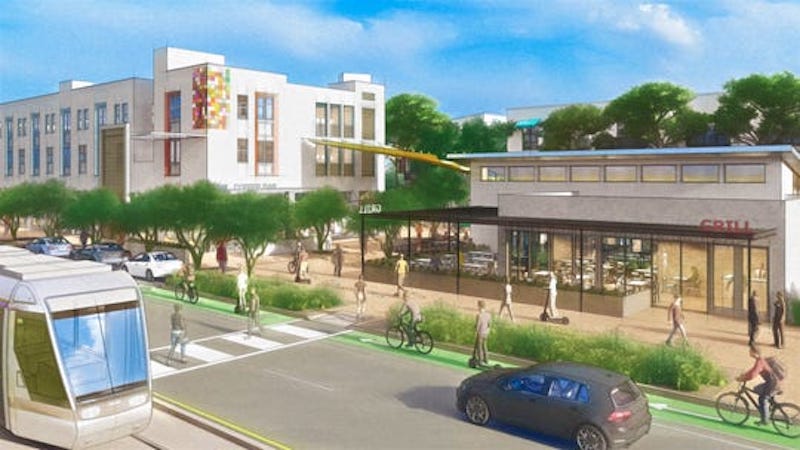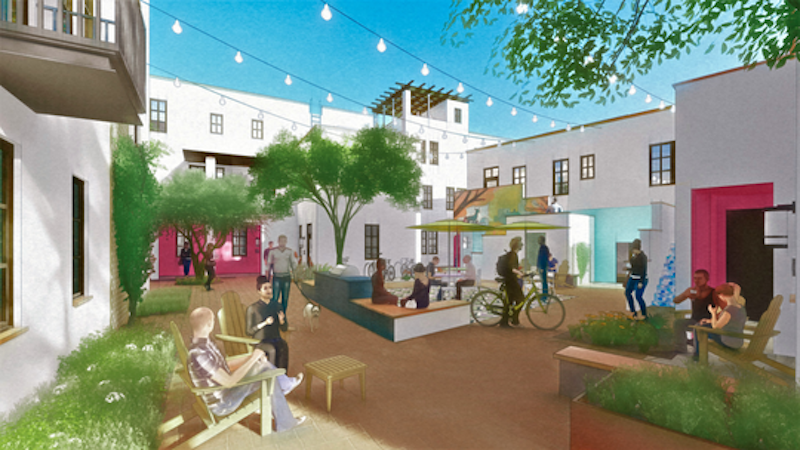Culdesac, a developer that specializes in building car-free neighborhoods from scratch, operates with a key insight in mind: the way we move defines the way we live. And because how we move is changing, thanks to things like ridesharing, the way we live should change as well.
As such, Culdesac Tempe, currently under construction on a 16-acre site in Tempe, Ariz., will be the first car-free neighborhood built from scratch in the United States, according to the developer. The $140 million project will provide 636 apartments for approximately 1,000 residents, with space for zero private cars. That’s right, if you want to live in Culdesac Tempe, you will need to leave your wheels behind. The neighborhood’s one small mini-lot will be stocked with hourly rentable car-sharing, such as GetAround, Turo, or Zipcar, and the perimeter of the neighborhood will be stippled with rideshare pick-up zones.

Space that is typically set aside for streets and parking lots will instead be used for acres of greenspace, courtyards, and shops. Not having to create a maze of pavement for vehicles means more than half of the land area will be covered in landscaping and greenery, a ratio not seen in urban developments.
See Also: Redefining lost urban spaces: 5 ways to turn a laneway into a “lanescape”
But Culdesac Tempe doesn’t plan on leaving its residents stranded without any transportation besides their own two feet. The neighborhood will bring together services like ridesharing, shared bikes and electric scooters, same day grocery delivery, and an on-site light rail station that connects to the downtown to mitigate any headaches associated without having a private vehicle. The neighborhood will also feature a pool, a dog park, and a gym.
Another interesting idea Culdesac Tempe will be trying looks to reimagine the guest room. Instead of private guest rooms, which often times aren’t even used, residents will be able to put up friends in bookable guest suites strategically placed throughout the neighborhood.
Culdesac Tempe is slated to launch in late 2020.
Related Stories
Urban Planning | Oct 30, 2024
Bridging the gap: How early architect involvement can revolutionize a city’s capital improvement plans
Capital Improvement Plans (CIPs) typically span three to five years and outline future city projects and their costs. While they set the stage, the design and construction of these projects often extend beyond the CIP window, leading to a disconnect between the initial budget and evolving project scope. This can result in financial shortfalls, forcing cities to cut back on critical project features.
Designers | Sep 20, 2024
The growing moral responsibility of designing for shade
Elliot Glassman, AIA, NCARB, LEED AP BD+C, CPHD, Building Performance Leader, CannonDesign, makes the argument for architects to consider better shade solutions through these four strategies.
Multifamily Housing | Aug 21, 2024
Nation's leading multifamily developer expands into infrastructure
Greystar's strategy for infrastructure is driven by the shifting landscape of today's cities—primarily in the increased digitization, urbanization, and transitions to clean energy.
Urban Planning | Aug 15, 2024
New York City begins first large-scale porous pavement installation
New York City is installing its first large-scale porous pavement installation along seven miles of roadway in Brooklyn. The project will keep 35 million gallons of stormwater out of the combined sewer system each year, according to a news release.
Urban Planning | Aug 15, 2024
The magic of L.A.’s Melrose Mile
Great streets are generally not initially curated or willed into being. Rather, they emerge organically from unintentional synergies of commercial, business, cultural and economic drivers. L.A.’s Melrose Avenue is a prime example.
MFPRO+ News | Jul 22, 2024
6 multifamily WAFX 2024 Prize winners
Over 30 projects tackling global challenges such as climate change, public health, and social inequality have been named winners of the World Architecture Festival’s WAFX Awards.
Urban Planning | Jun 10, 2024
N.Y. governor halts Manhattan traffic congestion pricing plan
New York Gov. Kathy Hochul says she is indefinitely delaying the implementation of congestion pricing in Manhattan just weeks before the plan was to take effect. The controversial plan would have had drivers pay $15 to enter Manhattan south of 60th street.
Urban Planning | May 28, 2024
‘Flowing’ design emphasizes interaction at Bellevue, Wash., development
The three-tower 1,030,000-sf office and retail development designed by Graphite Design Group in collaboration with Compton Design Office for Vulcan Real Estate is attracting some of the world’s largest names in tech and hospitality.
Mixed-Use | May 22, 2024
Multifamily properties above ground-floor grocers continue to see positive rental premiums
Optimizing land usage is becoming an even bigger priority for developers. In some city centers, many large grocery stores sprawl across valuable land.
Sustainable Development | May 10, 2024
Nature as the city: Why it’s time for a new framework to guide development
NBBJ leaders Jonathan Ward and Margaret Montgomery explore five inspirational ideas they are actively integrating into projects to ensure more healthy, natural cities.

















